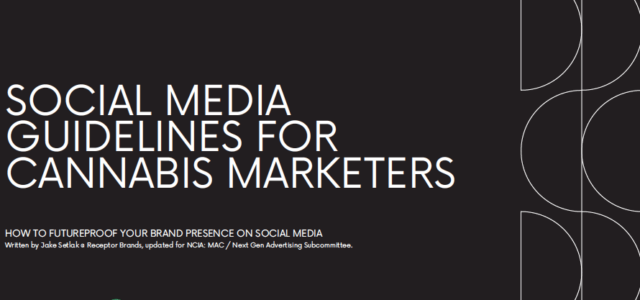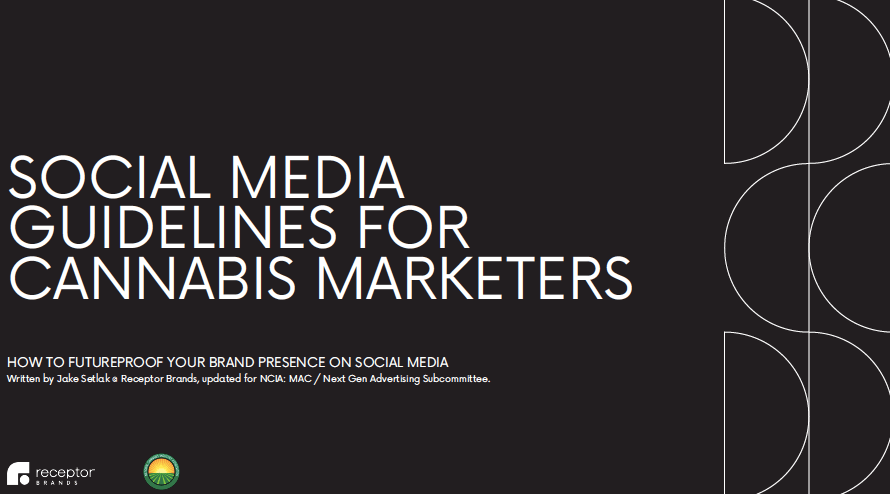Committee Blog: Five Best Practices to Future-Proof Your Cannabis Brand on Social Media
Marijuana Laws, Regulations, & PoliticsUncategorized October 13, 2021 MJ Shareholders 0


By Jake Setlak, Receptor Brands on behalf of NCIA’s Marketing & Advertising Committee
Social media platforms can be perilous for cannabis businesses. Every brand feels the need to have a presence on social media. Their typical approach is to accumulate followers by posting what you think those followers want to see. Then one day, without notice, those followers — and the platform algorithm’s understanding of why your brand was relevant to them — vanishes. Cannabis brands on social media are surrounded by so much gray area, it’s hard to know what makes your presence vulnerable to risks of suspension or worse. To help brands avoid those gray areas, here are five practices to help cannabis marketers future-proof their brands on social media.
1. Embrace standards.
Brands are held to higher standards on social media than users are. This is especially true for brands in regulated categories like cannabis. Why? Standards help protect against fraud and deception. These protections serve both consumer (users) and commercial (brands, businesses) interests across a wide variety of media channels. Think: truth in advertising and consumer protection laws. Get familiar with the federal, state, and municipal or regional laws that apply to all commercial interests where your cannabis brand operates (or find someone to do this on your behalf).
2. Think about your reputation.
How you behave on social media says a lot about your brand. There’s more than content to consider — bad behavior can permanently discolor your brand’s reputation. Why? Everyone can see what you’re doing. Openly engaging in deceptive practices shows consumers, partners, and regulators that your brand isn’t trustworthy. Those duplicate and back-up Instagram profiles? They signal to the rest of us that you know you’re taking risks. That could be all it takes to inspire someone to flag or report you. Social platforms notoriously rely on users to police the community — if users like you don’t report violations, the platforms tend not to know about them.
3. Safeguard your brand’s presence.
This is worth repeating, regardless of being in cannabis or another category: avoid getting banned. Why? No back-up profile can magically restore lost followers and engagement. When social media platforms decide to allow cannabis brands to use paid advertising, you’ll be locked out. This is why it’s important to set clear goals and objectives for maintaining your brand’s social presence.
Establish a compliance strategy for your social media efforts with three must-haves:
- Social Media Policy for Employees
- Community Management Guidelines & Protocols
- Legal Counsel (professional advice regarding cannabis category regulations, truth-in-advertising standards and consumer protection laws, and social media platform policies)
4. Know what you can say and how you can say it.
Be careful not to misinterpret another brand’s social media activity as setting a precedent for yours. Why? Seeing someone else break the rules is not license or permission for us to break those same rules. Plus, let’s face it — legitimate cannabis brands are already working uphill against prohibition-era prejudices. Know a bad example when you see one, and more importantly know what you can say and how you can say it on social media platforms.
What you can say:
- DO stick to “social” objectives. Take the higher ground. Speak from your brand values, not necessarily what the “insta” know-it-alls might insist. Be a valuable presence in the community, not just more clutter in their feed.
- DON’T antagonize the community. Remember, you’re a commercial interest and held to higher standards than users. It looks bad when brands argue with competitors, followers, or other brands. The Internet is full of trolls who prey and depend on your impulsive responses — even if it isn’t your aim to deceive or misinform, you may already be a target because of the stigma that still comes with cannabis.
How you can say it:
- DO communicate generally. Make observations. Be insightful. Grow your audience. Engage the community.
- DON’T advertise or promote. Explicit calls-to-action (CTAs) like “get”, “find”, “try”, or “buy” aren’t allowed for cannabis, especially on platforms where you can’t guarantee your audience is of a compliant age. This is the same reason you want to avoid depicting or promoting over-consumption.
5. Set the bar higher.
Aim to be the most upstanding citizen in the cannabis community. Why? No one knows when federal legalization will happen or how quickly a platform’s policies will change. This means no one can say it’s too soon to start preparing for such an eventuality!
There are four ways you can start raising the bar right now:
Make content that makes a difference.
Content creation for startups and small businesses doesn’t have to be overwhelming. Start with measurable objectives that justify your content creation process and budget. Scale your efforts toward more effectiveness, not merely more frequent posts. Set aside time to regularly evaluate and optimize your efforts. This is where well-placed focus will go a long way for you. It might take more effort to get beyond the “recommended” or popular approaches, but you will discover that you move faster and spend less when you go with what you know: the meaning and value your brand offers the cannabis community.
Apply paid advertising standard to organic content.
These apply to paid advertising but may in some cases also apply to organic content posted by commercial interests (brands). Platforms change frequently and without warning, so it’s wise to stay current on the policies and guidelines of the platforms you use.
Here are helpful resources for the five social platforms where many brands — regardless of category — typically start on social media. Enforcement may still be a mystery in many cases, but these policies help us understand when a post or profile might venture into gray areas and risk a suspension or worse.
Take cues from similarly regulated categories.
The beverage alcohol industry has multiple efforts to self-regulate advertising and marketing content.
Develop proactive standards that are poised for federal legalization.
Start by getting familiar with the voluntary marketing and advertising codes already emerging in the cannabis industry.
____
Jake Setlak is a founding member and head of Creative Strategy / Brand Experience at Receptor Brands, an agency custom-made for cannabis that transforms relationships between cannabis brands and their customers. Prior to his work in cannabis, Jake spent 20 years guiding the digital transformation of some of the world’s biggest brands and their advertising agencies. He’s worked in social media channels since before they were called “social media” and invented the Facebook Comment Ad format (now known as the boosted or promoted post). Jake is a member of NCIA’s Education Committee but produced this content while a member of the Marketing & Advertising Committee and serving on its Next-Generation Advertising subcommittee.
MJ Shareholders
MJShareholders.com is the largest dedicated financial network and leading corporate communications firm serving the legal cannabis industry. Our network aims to connect public marijuana companies with these focused cannabis audiences across the US and Canada that are critical for growth: Short and long term cannabis investors Active funding sources Mainstream media Business leaders Cannabis consumers









No comments so far.
Be first to leave comment below.